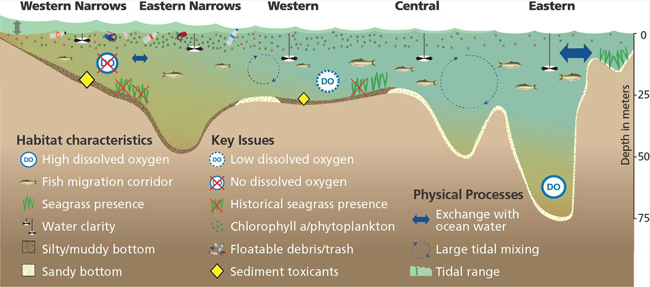Stony Brook, NY, June 8, 2015 - Two events — one in Connecticut and one in New York, both organized by the National Fish and Wildlife Foundation (NFWF) — took place today to announce the Long Island Sound report card on the ecosystem health of the Sound.
This Eco Health Report Card — which compared five water quality indicators including, dissolved oxygen, nitrogen, chlorophyll a, phosphorus and water clarity — was developed by the Integration and Application Network of the University of Maryland Center for Environmental Science with funding from the Long Island Sound Futures Fund, a program administered by NFWF, and the Long Island Sound Funders Collaborative.
The Maryland team found that there was a clear gradient in water quality, with grades ranging from excellent in the eastern Sound to poor in the western Sound.
The westernmost part of the Sound, the Western Narrows, which is affected by the highly populated suburban-urban communities surrounding New York City, received a very poor grade.
Further east, the water quality improves, as pollution is diluted by increased water exchange with the Atlantic Ocean.
The key to the grading system is that there are ways that people in each area can help improve the water quality of the Long Island Sound. For more, see the "Take Action" section of this Eco Heath Report Card, ecoreportcard.org/report-cards/long-island-sound/take-action.

Variation of habitat characteristics, key issues, and physical processes of Long Island Sound from west to east. For more, see the "Issues" section of this Eco Health Report Card, ecoreportcard.org/report-cards/long-island-sound/issues.
The report’s release received extensive press coverage, including Newsday, Danbury News Times, News 12 in Connecticut and New York, the Hartford Courant, and the Associated Press.
The grades can be viewed on the report card website at www.longislandsound.ecoreportcard.org.
More Info: Long Island Sound Study
Long Island Sound is one of the 28 nationally-designated estuaries under
the NEP, which was established by Congress in 1987 to improve the
quality of Long Island Sound and other places where rivers meet the sea.
The Long Island Sound Study, conducted under the Environmental
Protection Agency’s (EPA) National Estuary Program (NEP), is a
cooperative effort between the EPA and the states of Connecticut and New
York to restore and protect the Sound and its ecosystems.
For more on what you can do to make a difference, click over to the "Get Involved" or "Stewardship" sections of the Long Island Sound Study's Web site. News on the Long Island Sound Study can also be found in New York Sea Grant's related archives.
If you would like to receive Long Island Sound Study's newsletter, please visit their site's homepage and sign up for the "e-news/print newsletter" under the "Stay Connected" box.
For daily updates and tips on how you can help protect and restore Long Island Sound, please join LISS on Facebook, Twitter or, sign up for their RSS feeds.
More Info: New York Sea Grant
New York Sea Grant (NYSG), a cooperative program of Cornell University
and the State University of New York, is one of 33 university-based
programs under the National Sea Grant College Program (NSGCP) of the
National Oceanic and Atmospheric Administration (NOAA). The NSGCP
engages this network of the nation’s top universities in conducting
scientific research, education, training and extension projects designed
to foster science-based decisions about the use and conservation of our
aquatic resources. Through its statewide network of integrated
services, NYSG has been promoting coastal vitality, environmental
sustainability, and citizen awareness about the State’s marine and Great
Lakes resources since 1971.
New York Sea Grant maintains Great Lakes offices at SUNY Buffalo, the
Wayne County Cooperative Extension office in Newark and at SUNY Oswego.
In the State's marine waters, NYSG has offices at Stony Brook University
and Stony Brook Manhattan, in the Hudson Valley through Cooperative
Extension in Kingston and at Brooklyn College.
For updates on Sea Grant activities: www.nyseagrant.org has RSS, Facebook, Twitter, and YouTube links. NYSG also offers a free e-list sign up via www.nyseagrant.org/coastlines for its flagship publication, NY Coastlines/Currents, which is published several times a year.